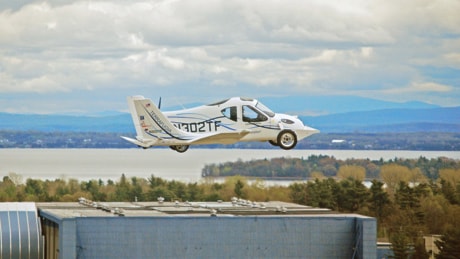TORONTO — It might not have the classic lines of Chitty Chitty Bang Bang, or the space-age appeal of the airborne fishbowl George Jetson had, but this flying car is real — and it might be sitting in your neighbour’s garage in two years.
For years, the prospect of owning a flying car has seemed more childhood fantasy than reality — always in development but never quite in production.
But a Massachusetts team of engineers say their creation could be in our skies and on our roads as early as 2011.
Carl Dietrich, a graduate of the Massachusetts Institute of Technology, and a team of highly educated aerospace engineers and hobby pilots have developed what they call “a roadable plane” that can fit into your garage, drive you to work, even fly you to Montreal.
The Terrafugia Transition, which takes its name from Latin (terra meaning “land” and fugia meaning “fugitive,” or “to flee”) took to the skies for the first time in March, and has since flown close to 30 more times.
Dietrich’s creation, which looks something like a cross between a Volkswagen, a Cessna and an escapee from a Walt Disney movie, is the latest in a long line of would-be flying cars.
But with an eight-metre wingspan and the ability to both fly and drive at over 115 km/h, the Terrafugia may not end up a never-was.
On the road, the two-seater vehicle is powered by a front-wheel-drive combustion engine fuelled by unleaded gasoline. In the air, that same fuel is used to power a propeller, mounted directly behind the cockpit/driver’s cab.
There’s just one prototype of the vehicle so far, but Dietrich, who conceived of the project four years ago, expects the first Terrafugia to ship in 2011.
People have long dreamed of driving their cars off the road and into the sky.
In fact, years before Ian Fleming penned the tale of Caratacus Pott’s excursion above the shores of the English Channel in his trusty winged sports car, the idea of a flying car seemed more like a scientific inevitability than a futuristic fantasy.
Even Henry Ford, chairman of the Ford Motor Company, believed the flying car would come.
“Mark my word: A combination airplane and motor car is coming,” he said in 1940.
Of course, we’re still waiting.
In the 1950s, the Malton-based Avro Aircraft Ltd., creators of the ill-fated Arrow and Jetliner, built two prototype “Avrocars” for the U.S. Air Force. The cars, which looked more like flying saucers out of an H.G. Wells book than cars, were basically two seats strapped on top of a massive turbine.
Avro believed the cars might eventually be akin to combat jeeps in future wars.
The cars never really flew more than a metre or so off the ground and the project was cancelled in 1961.
And for the last three decades, a Canadian-born engineer has stood out as a leader in the development of the first commercially available flying car, but still suffers setbacks.
Paul Moller, founder of Moller International Inc. and creator of the Skycar, has been building flying cars for years. But his most recent, the M400, a four-seater “car” designed to lift off from your driveway like a helicopter and then fly up to 1,200 kilometres at speeds in excess of 500 km/h, has been dubbed a failure by some and his company recently filed for bankruptcy protection.
So what sets the Terrafugia Transition apart from the rest?
“We call ours a ‘roadable aircraft’ instead of a flying car,” explains Andrew Heafitz, 39, one of the lead developers of the Terrafugia.
“Moller, he’s been working on that (flying car) for a long time. His concept is that you will be able to take off out of your driveway. That’s a much more complex idea than what we’re doing.”
“We’re not trying to replace anyone’s car,” he says. “We’re hoping that this might replace your aircraft.”
The Terrafugia Transition is more like a Cessna that can double as a car, not the other way around.
Heafitz admits the Terrafugia isn’t exactly the most ideal choice for a daily driver.
“You might not want to take it to the supermarket,” he says.
Although, “we are designing it with bumpers, and we’re trying to make the parts that might get scuffed up in parking lots a bit more resilient than your average airplane parts would be.”
The vehicle is expected to cost about $200,000. The group has already received more than 60 orders.
Once it passes all the road safety requirements to drive on American and Canadian roadways, Heafitz says the Terrafugia will actually be one of the safest planes in the air.
Heafitz says, “If you fly into bad weather, you could land and just keep driving to your destination.”
A brief history of flying cars:
1917: Glenn Curtiss unveils the Autoplane. It had a propeller behind the cockpit and three wings spanning 12 metres, but didn’t really fly so much as hop off the ground.
1937: Waldo Waterman invents the Arrowbile, a three-wheeled, planelike thing built from a Studebaker. The Arrowbile came with detachable wings but failed to attract investors.
1949: Moulton Taylor designs and flies the Aerocar, basically a compact car with detachable wings that could fly and drive. The Aerocar received FAA approval and even caught the eye of the Ford Motor Co., which considered, albeit briefly, marketing the vehicle. It too failed because Taylor was unable to get the number of buyers needed for mass production.
1959: Avro Aircraft Ltd. designs the Avrocar for the U.S. Air Force. Meant to operate as some sort of flying-saucer-like-jeep, the project suffers a similar fate as the Avro Arrow.
1965-present: Paul Moller develops a series of Skycars. His first attempt hovers just off the ground and looks more like a flying hamburger than a car. His latest, the M400, looks like a cross between a Harrier Jet and the Batmobile.
Source: Howstuffworks.com
